
Think of the Conflicting Viewpoints Passages as a debate: two or more parties state their conflicting beliefs. Sometimes they agree on one point but disagree on others. Conflicting Viewpoints Passages present this argument and expect you to identify the Scientists’/Students’ beliefs and the similarities and/or differences in beliefs.
There will only be 1 Conflicting Viewpoints Passage on the ACT Science section (out of 7 total passages). It can appear at any point throughout ACT Science. To read about the other types of passages, check out our article on the 3 Types of ACT Science Passages.
In this article, I will:
- Break down the format of the Conflicting Viewpoints Passages
- Address the two types of questions you will be asked in Conflicting Viewpoints Passages and provide ACT Science practice questions for each type:
- Understanding Viewpoints Questions
- Comparing Viewpoints Questions
- Discuss the ACT Science strategies for attacking these passages
Format of Conflicting Viewpoints Passages
Overview of the format of Conflicting Viewpoints Passages
- Introduction
- Visual (if there is one)
- Scientist 1 / Student 1
- Scientist 2 / Student 2
- If there are more than 2 Scientists / Students, their paragraphs follow in sequential order.
- 7 Questions
I will delve into more information on each part below:
Introduction
The introduction will vary in length from a short paragraph to a long list. This is what a short introduction might look like:
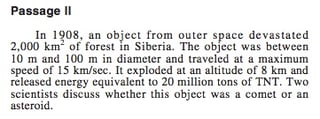
taken from an ACT Science practice test
This is what a long introduction might look like:
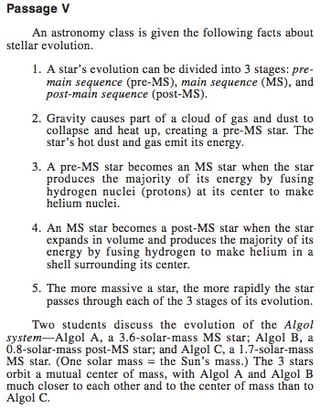
taken from an ACT Science practice test
No matter the length, the introduction to the Conflicting Viewpoints Passage is always important. Do not ignore the introduction or forget about it as there is usually one question that you cannot answer without reading it.
Visual
There may not be a visual in your Conflicting Viewpoints passage; only about half of the Conflicting Viewpoints Passages have a visual. The visual will not be a graph or table, but rather just an image/diagram of what is being discussed such as this one:
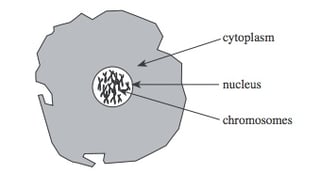
taken from an ACT Science practice test
The visual is not usually necessary to answer any questions, but rather it is just there to help you imagine what is being discussed. For example, the visual above provides no data; it simply shows the location of the nucleus, chromosomes, and cytoplasm in the cell. The majority of the questions will instead ask about:
Scientist 1 / 2 / 3 or Student 1 / 2 / 3
This is the meat of the passage. This is where the points of view of each scientist/student are fleshed out. Pay close attention as you read. The bulk of the questions ask you about this part. Also, do not get thrown off if they disguise points of view as different theories such as in this Conflicting Viewpoints Passage:
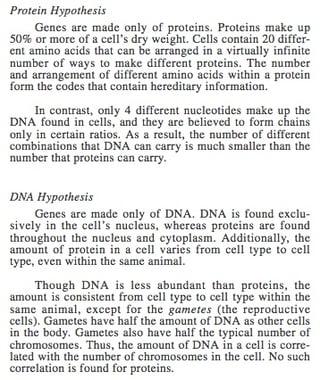
Make sure you identify the similarities and differences of each person or theory. If you are having trouble identifying the point of view, I recommend looking at the first and last sentence of each person's mini-passage. Usually, the main idea is spelled out there. In the example above, the first sentences of Protein Hypothesis and DNA Hypothesis state the point of view. Understanding the points of view fully will serve you best when you start attempting questions:
Conflicting Viewpoints Passages Have 7 Questions
There are always 7 questions, no more, no less. There are two types of ACT Science questions used with Conflicting Viewpoints Passages that I will delve into next:
- Understanding Viewpoints Questions
- Comparing Viewpoints Questions
Now that we have an overview of what this type of passage entails, we'll dig into the two types of questions that come along with this passage:
Understanding Viewpoints Questions: What They Are and How to Answer Them
As I said above, the Scientist 1 / 2 portion will present each Scientist's point of view with the supporting points. These questions check to make sure you really understand each author's/theory’s point of view. Here are some example Understanding Viewpoints questions:
- What would Student 2 predict to happen?
- Scientist 1 would most likely agree with:
- Which statement most agrees with the DNA Hypothesis?
- A. Genes are mostly proteins
- B. DNA is found throughout the nucleus and cytoplasm
- C. Protein is found only in the cell's nucleus
- D. DNA is found only in the cell's nucleus
Let's attempt some ACT Science practice questions using the Conflicting Viewpoints Passage above, keeping in mind the:
Rules for Answering These Questions:
ACT Science Tip #1 - Make sure you are considering the right point of view. If it asks about Scientist 1, make sure you are looking at Scientist 1’s paragraph. The ACT will always have an answer choice with Scientist 2’s point of view, hoping that someone will fall for that incorrect answer.
In the last question above, you are asked about DNA Hypothesis, so make sure you are looking at DNA Hypothesis, not Protein Hypothesis. If you accidentally looked at Protein Hypothesis instead, you would have incorrectly chosen answer A.
ACT Science Tip #2 - Some questions require logic as well as understanding the point of view such as the last question above:
Which of the following would support the DNA Hypothesis?
A. Genes are mostly proteins
B. DNA is found throughout the nucleus and cytoplasm
C. Protein is found only in the cell's nucleus
D. DNA is found only in the cell's nucleus
You need to understand the DNA Hypothesis so that you are able to figure out which of the answer choices would support it. On these "which of the following..." questions, process of elimination is your best weapon. Eliminate the answer choices that only support Protein Hypothesis and that do not support DNA Hypothesis. Ideally, after all of your eliminating, you will be left with one answer choice. Double check that the answer choice does indeed support DNA Hypothesis.
For the question above, we can eliminate answer choice A because it supports Protein Hypothesis. We can eliminate answer choices B and C because it directly contradicts what is stated in the DNA Hypothesis. In the DNA Hypothesis, it says that DNA is found exclusively in the cell's nucleus, so D is the correct answer.
ACT Science Tip #3 - Some questions are as easy as repeating a fact. Some questions will ask you to just relay facts you read in the passage such as:
According to Protein Hypothesis, genes are made only of:
This question just requires you to go back and look at the Protein Hypothesis paragraph. The Protein Hypothesis paragraph says that genes are made only of proteins, so that is the answer. Again, make sure you are looking at the right section. These questions are easy, but it is also easy to make a careless mistake on these questions.
ACT Science Tip #4 - Ignore the validity of the viewpoint. Sometimes one viewpoint will be factually false, and you will know it from your previous science studies. Ignore it! You still need to understand the viewpoint and be able to answer questions about it.
If a viewpoint said that the Earth is the center of the Solar System and you were asked what best supported this viewpoint, you would need to pick an answer choice that supported it such as “respected philosopher Aristotle taught this model.”
Even though you know the viewpoint is false, you need to be able to articulate the point of view and its supporting arguments.
ACT Science Tip #5 - Your understanding needs to go beyond talking about each point of view distinct from one another, which leads us to the other type of question:
Comparing Viewpoints Questions: What They Are and How to Answer Them
These questions ask you to point out the similarities and differences between the authors. Here are some example Comparing Viewpoints questions:
- Student 1 and 2 both agree that:
- Which of the following would support student 1, but not student 2?
- DNA Hypothesis and Protein Hypothesis both agree that:
- A. DNA is less abundant than proteins
- B. DNA is found throughout the nucleus and cytoplasm
- C. Protein is found only in the cell's nucleus
- D. Genes are made up only of DNA
Let's attempt some Comparing Viewpoints ACT Science practice questions from the same passage keeping in mind the same rules as before:
ACT Science Tip #1: Make sure you're considering the correct point of view and answering the correct question. This is especially important on the Conflicting Viewpoints questions that ask, "Which of the following would support Student 1, but not Student 2?" You should circle and/or underline the Student you are looking to support, in this case, Student 1. Put an X through the Student you are not looking to support. Such as I have done below:

This step helps you concentrate on the correct point of view. For these fact-finding questions, make sure you're reading the correct section for both viewpoints. ACT Science Tip #3: Some questions simply ask you to restate the information stated in both viewpoints. Let's attack this fact-finding Conflicting Viewpoints question from the passage above:
- DNA Hypothesis and Protein Hypothesis both agree that:
- A. DNA is less abundant than proteins
- B. DNA is found throughout the nucleus and cytoplasm
- C. Protein is found only in the cell's nucleus
- D. Genes are made up only of DNA
Consider first, what is the question asking us? The question asks us to find the statement that both DNA and Protein Hypothesis would agree with. To do this, you need to use process of elimination. Start by looking at A and work your way through the answer choices. Answer choice A is directly stated in DNA Hypothesis and Protein Hypothesis mentions that protein makes up over 50% of the cell, so A seems like a good choice.
However, I will check the others just in case. Answer choice B directly conflicts with DNA Hypothesis, which said DNA is only found in the nucleus. Answer choice C conflicts with DNA Hypothesis, which said that proteins are found throughout the nucleus and cytoplasm. Answer choice D conflicts with Protein Hypothesis because Protein Hypothesis argued that genes are made up only of proteins. So, Answer A is the correct answer.
ACT Science Tip #2: As with understanding viewpoints questions, some conflicting viewpoints questions require deeper logic. For these questions, understand the points of view, and then use reasoning to find the answer. For example, if you were asked,
Which of the following would support Protein Hypothesis, DNA Hypothesis?
A. Genes are mostly proteins
B. DNA is less abundant than proteins
C. Protein is found only in the cell's nucleus
D. DNA is found only in the cell's nucleus
Start by circling and/or underlining and/or crossing out as we did above:

Again, use process of elimination. If it supports both Protein Hypothesis and DNA Hypothesis, it is wrong. If it supports DNA Hypothesis and not Protein Hypothesis, it is wrong. Make sure you are looking at the correct section. Start with answer choice A and work your way through the questions, checking each one against what is stated in the viewpoints.
Answer choice A is directly stated in Protein Hypothesis and directly conflicts DNA Hypothesis, so it should be the correct answer. However, I will check the others. Answer choice B is in both Protein Hypothesis and DNA Hypothesis, which states, "DNA is less abundant than proteins," so B is incorrect. Answer choice C is not stated in Protein Hypothesis, and therefore, C does not support it. Answer choice D is directly stated in DNA Hypothesis, so it is incorrect. So, A is the correct answer.
Strategy for Conflicting Viewpoints Passages
Now that we have a full understanding of what these passages are like, what questions characterize this passage, and how to solve those questions, let's discuss the overall approach to integrating this all together. If you find yourself running out of time, you may find this approach especially helpful.
First off, Conflicting Viewpoints Passages will take you the longest because as I discussed above, you need to have a full understanding of the passage to answer the Understanding Viewpoints and Comparing Viewpoints questions. So save it for the very end - finish the other 6 passages before attempting this one or it will slow you down.
When attempting Conflicting Viewpoints Passages, read the whole passage first before looking at the questions. I discuss this more in depth in my article on time management. Since you need to read the introduction and all viewpoints to answer the questions, it makes the most sense to read the whole passage at the start.
If you find yourself struggling to remember who believed what, write yourself mini-summaries in the margins after reading each viewpoint such as “pro-comet theory.” Check out this example:
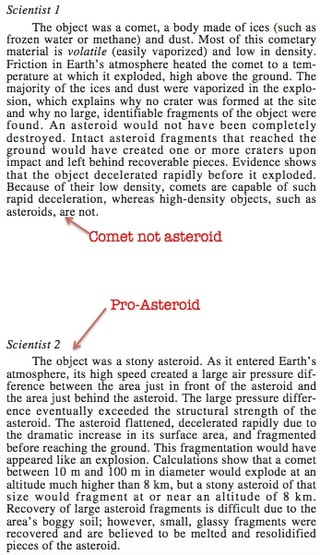
It will save you time, so you don’t have to re-read when answering questions. By doing this, you are also ensuring you understand the viewpoint, which is crucial to answering questions. When you start answering the questions, consider which viewpoint(s) you are asked about such as in this ACT Science practice question from the above passage:
Which of the following phrases best describes the major point of difference between the 2 scientists’ hypotheses?
A. The location of the event
B. The speed the object was traveling
C. The density of Earth's atmosphere
D. The type of object that entered Earth's atmosphere
In this Comparing Viewpoints problem, you are asked to define the major difference between Scientist 1 and 2. Well, according to our awesome notes, Scientist 1 thought the object was a comet, and Scientist 2 thought the object was an asteroid. While there may be other minor differences, this is the major difference in point of view, so the answer is D. You could use process of elimination on this question, but it would have taken longer than simply matching your summary to the best answer choice.
Now that we have learned the format, questions, and strategies behind the Conflicting Viewpoints Passage, I will summarize the steps we took when attacking Conflicting Viewpoints Passage and the common problems to avoid:
Steps to take when attempting Conflicting Viewpoints Passages:
- Read the entire passage first including the introduction.
- Write brief notes in the margins to remember each viewpoint's main argument.
- When answering questions, start by asking yourself which viewpoint does this question address?
- Use your notes to help answer questions.
- Use process of elimination to answer questions by eliminating answer choices that address the wrong viewpoint.
Common problems you should avoid when answering the questions:
- Reading the wrong viewpoint(s).
- Getting caught up in the validity of the viewpoint.
Recap
Conflicting Viewpoints Passages always have the same format:
- Introduction
- Visual (if there is one)
- Scientist 1 / Student 1
- Scientist 2 / Student 2
- If there are more than 2 Scientists / Students, their paragraphs follow in chronological order.
- 7 Questions
There are 2 types of questions:
- Understanding Viewpoints Questions
- Comparing Viewpoints Questions
For both types,
- Make sure you're considering the correct point of view and answering the right question.
- For fact-finding questions, make sure you're reading the right section for both viewpoints.
- For deeper logic questions, understand the points of view, then use reasoning to find the answer.
- Ignore the validity of crazy viewpoints.
Strategy
- Save this passage for last.
- Read the whole passage first.
- Write yourself short margin notes to remember each viewpoint.
- Answer the questions using these notes and process of elimination.
What’s Next?
I hope you feel ready to rock the Conflicting Viewpoints Passage!
For further learning on the ACT Science Section, read about the other 2 types of passages in our article, The 3 Types of ACT Science Passages. Learn about Time Management and Section Strategy for ACT Science. Also, learn about Time Management for the ACT Reading section and for the ACT Math section.
Like this article? Want to improve your ACT score by 4 points?
Check out our best-in-class online ACT prep program. We guarantee your money back if you don't improve your ACT score by 4 points or more.
Our program is entirely online, and it customizes what you study to your strengths and weaknesses. If you liked this Science lesson, you'll love our program. Along with more detailed lessons, you'll get thousands of practice problems organized by individual skills so you learn most effectively. We'll also give you a step-by-step program to follow so you'll never be confused about what to study next.
Check out our 5-day free trial:
Have friends who also need help with test prep? Share this article!

As an SAT/ACT tutor, Dora has guided many students to test prep success. She loves watching students succeed and is committed to helping you get there. Dora received a full-tuition merit based scholarship to University of Southern California. She graduated magna cum laude and scored in the 99th percentile on the ACT. She is also passionate about acting, writing, and photography.


































 Holly R.
Holly R.